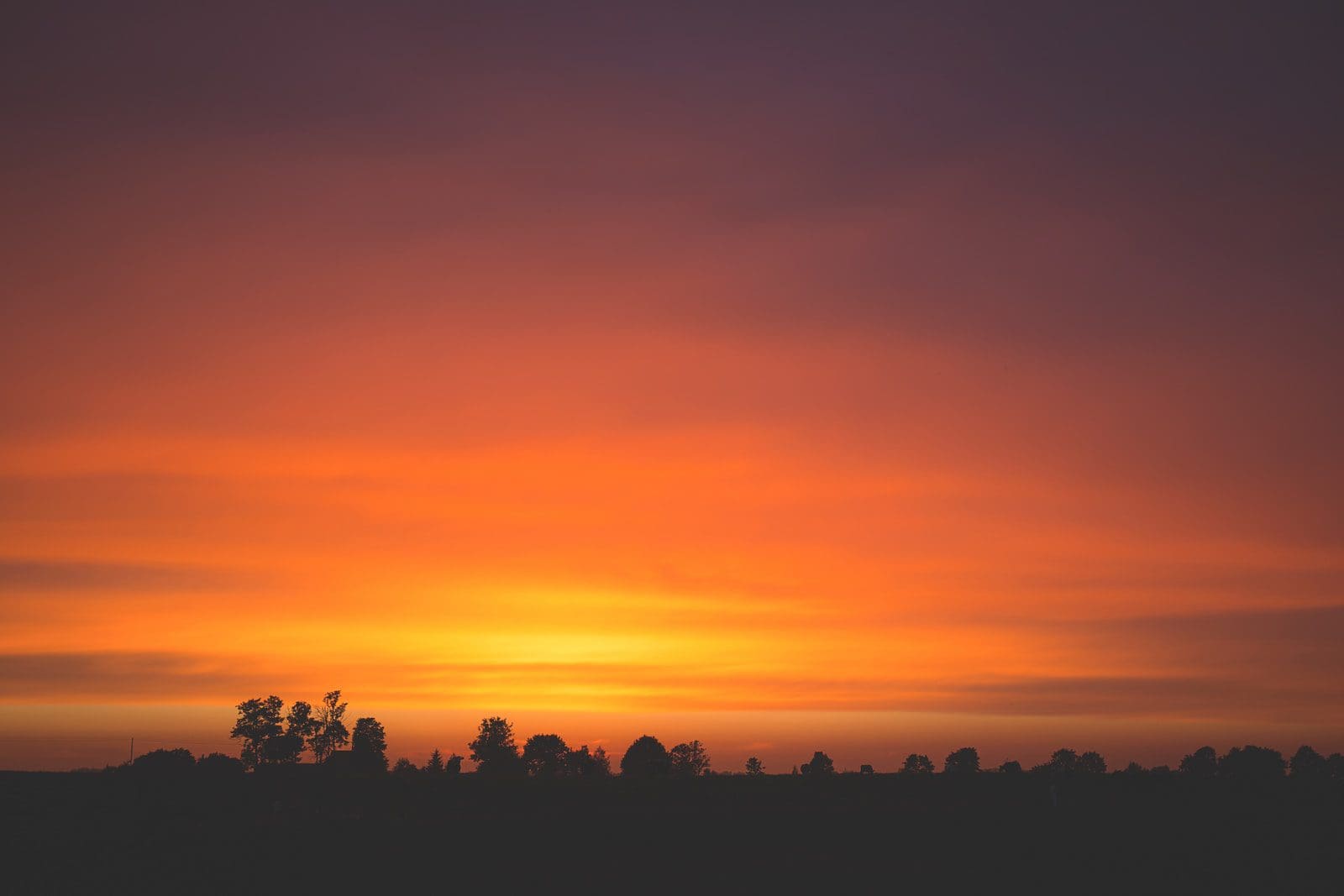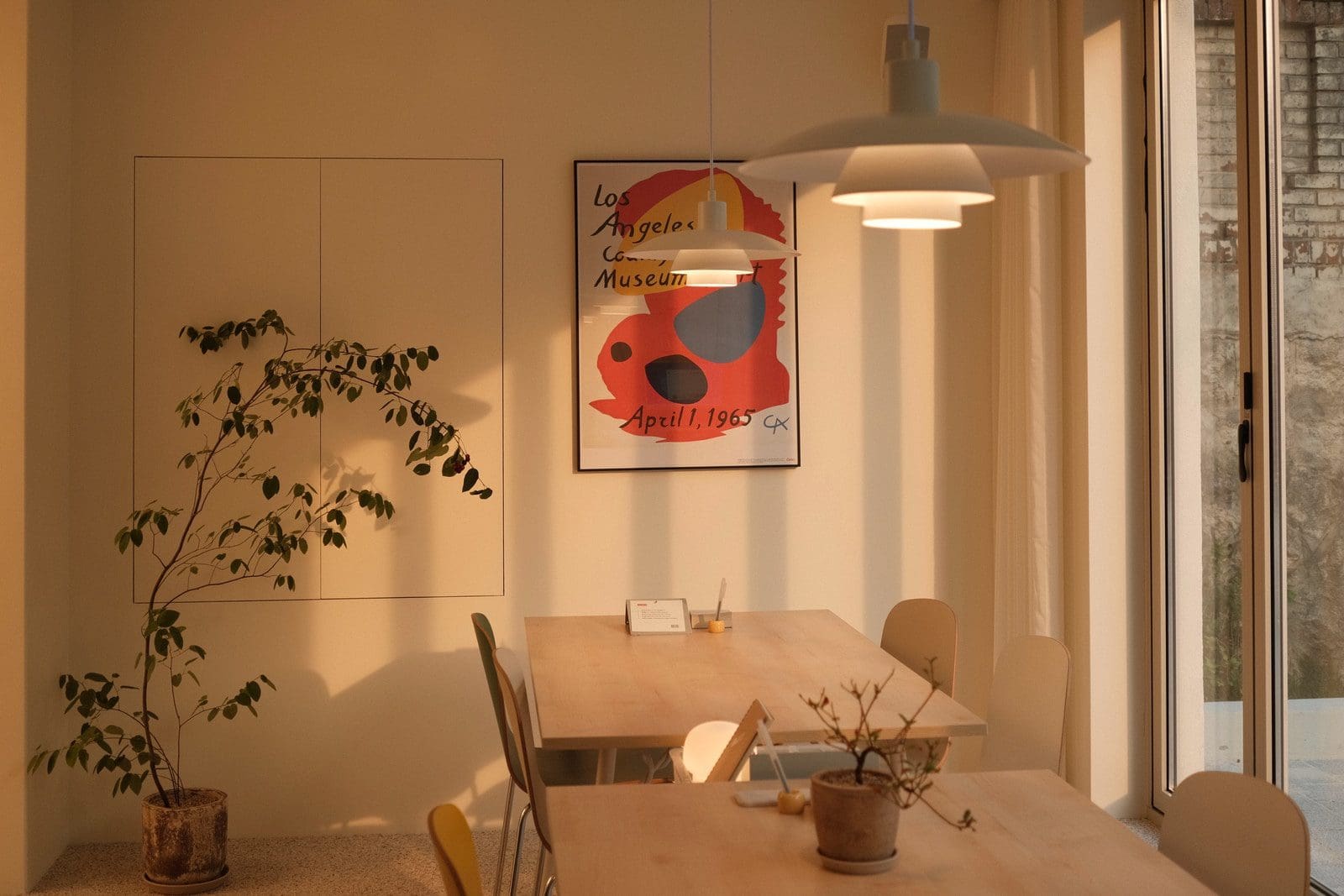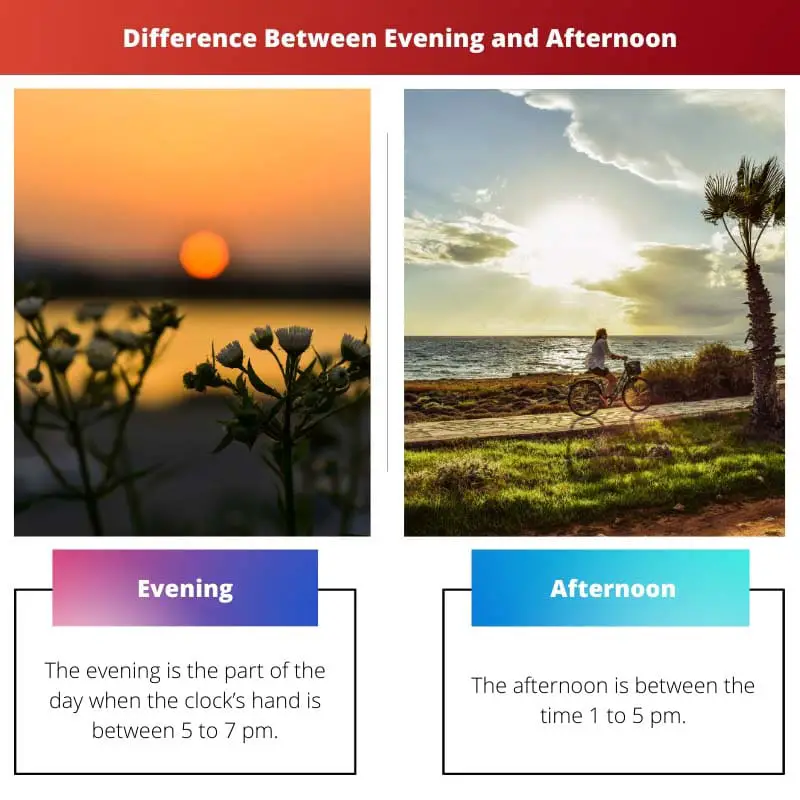Earth is the third planet from the Sun, also known as the “Blue Planet”, as it harbours life. Earth is tilted at an angle of 23.5 degrees.
It is the fifth-largest planet in the Solar System. The big world is Jupiter and then comes Saturn, Uranus, and Neptune.
The water covers 71% of the Earth’s surface. Morning, afternoon, evening, and night are the four parts of the day.
Morning is between 5 to 8 a.m., Afternoon is between 1 to 5 pm, Evening is the part between 5 to 7 pm, and Night is the time from 9 to 4 pm.
Daily greetings are also said or set according to the time part, such as if it is 11 am, we greet a person with “Good morning”, and the same rules go with other time parts.
Key Takeaways
- The evening is the time of day that follows the afternoon and precedes the night, starting around sunset and ending when darkness falls.
- The afternoon is between noon and evening, characterized by daylight and associated with work or daytime activities.
- Understanding the distinction between evening and afternoon is important for scheduling events, appointments, and activities based on the time of day.
Evening vs Afternoon
The evening is the period of time at the end of the day that starts at the end of the afternoon, marked by the setting of the sun around 5-6 p.m., and lasts till bedtime. The afternoon period starts at noon when the sun starts descending from its peak around 1 p.m. and ends in the evening.

Time Frame of Evening and Afternoon
The concept of evening and afternoon is subjective to different time zones, regions, and cultures. Generally, the afternoon extends from 12:00 PM (noon) to around 5:00 PM. On the other hand, evening begins after this time and lasts until nighttime.
Afternoon
- Starts: 12:00 PM (noon)
- Ends: Around 5:00 PM
Evening
- Starts: After 5:00 PM
- Ends: Until nighttime
The perception of afternoon and evening may continue to change with seasons and daylight saving time. For example, in summer, the hours of daylight are longer, and thus, the evening may be perceived to last longer. In contrast, in winter, the shorter daylight hours can cause many people to consider evening arriving earlier.
It is important to consider the cultural context when discussing the time frame of evening and afternoon. In some cultures, mealtimes, work schedules, and even siestas can shape the perceptions of these two timeframes.
Remember that the suggested timeframes are guidelines and may vary depending on your geographical location, cultural background, and personal preferences.
Comparison Table
| Parameters of Comparison | Evening | Afternoon |
|---|---|---|
| Part of the day | The evening is part of the day when the clock’s hand is between 5 to 7 pm. | The afternoon is between the time 1 to 5 pm. |
| Occurs at | The evening occurs at Twilight, or Dusk, which means at the time when the sunset. | On the other hand, the afternoon begins when the sun begins to descend from its peak. |
| Greetings | The greeting used when it is Afternoon is, “Good afternoon!” | While on the other hand, the greeting is “Good evening!” |
| Sun | The sun’s movement marks evening and afternoon; Evening occurs when the sun’s light starts decreasing, leading to Dusk. | On the other hand, the Afternoon is marked by the decrease in daylight. |
What is Evening?
The evening is that part of the day that occurs at the end of the Afternoon, i.e. at 5 pm. The specific time at which the evening begins depends upon a factor, that is, the location.
The timings of the evening are never constant; in other words, it keeps changing throughout the year. It may also be defined as the last part of the day, after which the sun sets. It is the second last part of a day if taken as a whole.
“Evening” is derived from Old English, which means “the coming of evening, sunset, time around sunset”. The term has been in use since the 15th century.
In some languages, the greetings are done as per the time of the day, such as people greet one another by saying “Good evening!’, however, it is also used when it is night because a person cannot say “Good night!” as it would not be grammatically correct. Therefore, they greet by saying, “Good evening!”

What is Afternoon?
The afternoon is the time part from 5 to 8 pm. It is the time part just before the evening, and after-noon, i.e. 12.
In other words, it is described as the period between noon and evening. According to this definition, it occurs between noon and evening, but the timings of noon and evening keep changing, leading to a change in the timings of the afternoon as well.
However, the evening has no standard deviation, but it is socially accepted as part of the day between 5 to 8 pm. In the afternoon, the sun is at a low angle. Hence, it is bright and glaring.
A few effects on life are caused due to the afternoon, such as Hormones, Body temperature, and Alertness.

Main Differences Between Evening and Afternoon
- The evening begins when the Afternoon ends, whereas, Afternoon begins afternoon and ends with the Evening.
- The evening is when the sun sets, or at Twilight; on the other hand, the Afternoon is when the sun starts descending from its peak.
- The evening starts at 5-6 pm and lasts around 8 pm, whereas, on the other hand, the Afternoon begins afternoon and ends around 5 pm.
- The evening starts when the people come back from work, prepare dinner, and ultimately retire to bed at the end of the Evening, whereas the Afternoon ends at this time.
- The evening is categorized as Dusk, whereas, on the other hand, the Afternoon is organised with the descending of the Sun.
Activities During Evening and Afternoon
Work Activities
During the afternoon, you may find yourself in various work-related tasks. This is the most productive time for many people, as it falls right after lunch and before the energy levels dip towards the end of the day. Some common afternoon work activities include:
- Attending meetings
- Responding to emails
- Collaborating with colleagues
- Completing tasks and projects
In contrast, evening work activities might be less common but can still be crucial for certain jobs. For those working in retail, hospitality, or entertainment industries, evenings can be the busiest and most important part of the day. Typical evening work activities might entail:
- Shift work
- Client dinners or networking events
- Late-night meetings with global teams
- Freelancing or working on a side hustle
Leisure Activities
Afternoon leisure activities tend to be more outdoor-oriented or focus on socializing. As the weather is warmer and inviting, you might want to take advantage of daylight hours to engage in activities as such:
- Going for a walk or jogging
- Meeting friends at a café or park
- Engaging in outdoor sports
- Visiting local attractions
Evening leisure activities, however, are associated with relaxation and winding down after a long day. They can range from solitary and laid-back activities to engaging, group-centred experiences such as:
- Watching TV or movies
- Reading a book or listening to music
- Attending concerts or theatre performances
- Spending time with family or dining out with friends
Remember, finding the right balance between work and leisure activities in the afternoon and evening can contribute to a more balanced and fulfilling life.
Health and Wellness Difference
When comparing the benefits of evening and afternoon activities, it’s essential to consider their impact on your health and wellness. Each period offers unique advantages, which can help you make informed decisions about your schedule.
You might experience higher energy levels in the afternoon as your body temperature peaks around 3 PM. This increase in body temperature and alertness can lead to more productive and efficient workouts, especially if you engage in physical activities at this time. Furthermore, research indicates that afternoon exercise reduces stress levels and improves mood.
On the other hand, evening activities present a different set of health-related benefits. Engaging in light exercises such as yoga or stretching during this time can effectively relieve stress and improve your sleep quality. Studies show that physical activity in the evening helps release tension accumulated throughout the day, preparing your body and mind for a restful night.
While exercising in the evenings has its perks, it’s crucial to be cautious of the intensity of your workouts. High-intensity exercises may disrupt your sleep cycle, as they can elevate your adrenaline and cortisol levels. To strike the right balance, consider performing relaxing and low-impact exercises during the evening, ensuring a proper balance between physical activity and rest.
In conclusion, choosing between evening and afternoon activities depends on your preferences and lifestyle. By understanding the health and wellness differences between these two timeframes, you can tailor your routine to maximize the benefits for your well-being.
Cultural Practices
In many cultures, afternoons and evenings hold different symbolic meanings and are associated with distinct customs and traditions. In this section, you will learn about some of these cultural practices.
The afternoon siesta is a tradition in southern European countries, such as Spain and Italy. This short nap is taken after lunch to rejuvenate and escape the day’s heat. Siestas are an important part of the daily routine where shops and businesses may close during this time, allowing employees and patrons to rest.
In contrast, evenings in these cultures are lively and social, with people gathering at bars, cafes, and other public places to enjoy drinks, tapas, and conversation. This practice is known as “passeggiata” in Italian and “paseo” in Spanish, meaning a leisurely stroll to enjoy the cool air, meet friends, and people-watch.
In Japan, the concept of the afternoon and evening transitions beautifully through a cultural practice called “yuagari.” This term refers to the moments following a bath in a hot spring or an onsen when individuals immerse themselves in relaxation, allowing the heat from the water to warm the skin and calm the mind. Yuagari is a magical time of day, a bridge between the active afternoon and the tranquil evening.
In various cultures worldwide, evening rituals involve storytelling, music, and dance. For example, traditional Aboriginal Australians gather during the evening to share stories about their ancestry and their environment, a practice known as the “Dreamtime stories.” Similarly, in Africa, evenings are when communities come together for storytelling, music, and dance, referred to as “griots” in West Africa. These activities create strong bonds and serve to preserve history and values.
You can see that afternoons and evenings play unique roles in cultural practices worldwide. As you interact with different cultures, it’s essential to appreciate and respect these distinctions, as they can offer insight into the values and customs that define each community.
Environmental Effects
Natural Light
During the afternoon, you can enjoy the benefits of natural light. The sun is high, providing bright and even illumination. This can be advantageous for activities requiring good visibility, such as reading or outdoor sports. Consider placing workspaces near windows or using lighter-coloured curtains to make the most of natural light in your home or office.
Temperature Changes
In the evening, temperatures drop as the sun begins to set. This can create a more comfortable environment for those sensitive to heat or prone to feeling warm throughout the day. You can open windows or use fans to create airflow to stay cool in the evening. Dressing in layers or using lightweight blankets can also help regulate your temperature at night, making the evening atmosphere more enjoyable and restorative.


This post adds a unique linguistic perspective to the discussion, which I find quite interesting.
It’s definitely an in-depth look at the topic.
I found the linguistic insights very engaging as well.
The gravity of Earth is the main reason it appears third in the Solar System.
Certainly adds more interesting facts to the discussion.
That’s an interesting point!
The comparisons provided in this post are quite helpful for understanding the differences between evening and afternoon.
Great post!
Absolutely, it’s a very detailed explanation.
This post is a bit too verbose for a simple topic like timeframes, but the information is detailed and accurate.
True, the verbosity doesn’t take away from the informative nature of the post.
I don’t mind the verbosity so much, I found the read enriching.
While this post is detailed, the repeated explanations are quite monotonous.
Yes, the content might benefit from a more concise approach.
I can see how that may be off-putting.
The writing of this post is a bit too flowery for my taste, but the information presented is still useful.
I understand what you mean, the elaborate descriptions might not suit everyone, but the post is overall quite informative.
I agree, the details are useful.
This article covers a wide range of cultural, linguistic, and geographical elements in its discussion of evening and afternoon, making it a well-rounded piece.
It’s a thorough analysis.
Agree, I found the linguistic context very fascinating.
I never knew about the cultural differences in perceiving evening and afternoon. This was an eye-opening read.
I appreciate the clarity in defining the timeframes for evening and afternoon. It makes for a comprehensive and educational read.
Agreed, especially the comparison table was very helpful.
Earth is a fascinating topic, and this post is very informative. It’s interesting to learn more about the details of our planet.
I agree, Earth is a mysterious and complex place.